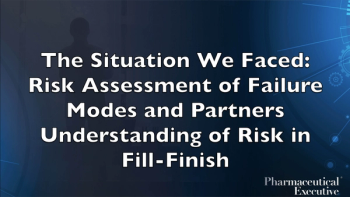
- Pharmaceutical Executive-10-01-2011
- Volume 0
- Issue 0
Fred Frank: Fortune and the Financier
Fred Frank, Vice Chairman, P.J. Solomon Co.
How much do fortune and good luck play in career success? In my case, it was luck plus a measure of foresight that put me on the frontline in building a new valuation model for the pharmaceutical industry. When I began my career as a freshly minted Stanford MBA in 1958, the US was in recession, Wall Street banking firms did not recruit on campus, and starting salaries in investment banking were the lowest of any industry. My goal was to find an opportunity with a top-flight investment research firm, and the only formal training program was at Smith Barney & Co. I was fortunate to join a training program of just three individuals.
Fred Frank
In 1959 I became a junior analyst. And good fortune struck again. The Partner I was assigned to was the "Chemical & Drug Analyst," as it was the norm on Wall Street to couple those industries. After working for Bill Grant (a wonderful mentor) for about a year, I said to him "Bill, there is no relationship between the chemical industry and the drug industry. You cover the chemical industry and I'll cover drugs." He concurred and just like that I became Wall Street's first dedicated drug industry analyst. It's hard to put in perspective how small the industry was at that time. The then-largest Rx company was American Home Products (now Pfizer from the acquisition of Wyeth), with total revenues of around $3 billion and only about 60 percent of its revenues in prescription drugs.
Fast forward to 1976. What happened to transform the industry? The introduction of Tagamet (cimetidine) by Smith Kline & French—which became the first "blockbuster drug." From an industry that prior to 1976 had a price-to-earnings ratio below that of the Dow Jones Industrial Average, the capitalization rate increased steadily to where the industry commanded an average p/e ratio of 2.2 times above that of the DJIA p/e ratio in 2000.
Several important "factoids" derive from this: 1) the blockbuster era produced a dramatic shift to chronic care drugs from acute care drugs, the main effect of which was the higher revenues from a regimen of therapy because these drugs are taken for long periods of time; 2) the industry learned that the easier route to success was to develop "best-in-class" fast-follower drugs compared to the more challenging undertaking of discovering "first-in-class" agents; 3) leading companies morphed from being domestic to international companies (mainly Europe), and later global enterprises; 4) a rigorous pursuit of growth focused on large-scale acquisitions, resulting in the disappearance of the great family-owned Rx companies like Upjohn, Rorer, A.H. Robins, Marion, and Squibb; and 5) the emergence in 1980 of public ownership of the biotechnology industry with the IPO of Genentech.
That IPO was an astonishing "happening." The company offered 1 million shares at $35 per share. The first day of trading, the stock reached $88 per share and closed at $77. This was long before the dot-com explosion. I was pleased to be associated as a principal in driving that groundbreaking deal to completion. Many others have followed.
The emergence of the biotech industry as public companies spawned a new phenomenon: publicly traded venture capital companies that generate large amounts of capital for investment. The second biotech company to go public clearly shows the nature of this phenomenon: the Cetus IPO in early 1981 raised $122 million for a very-early-stage company with yet no products on the market. What an era!
The Rx industry's reign as a premium p/e ratio arena ended abruptly in 2000 with the beginning of blockbuster drug patent expirations; the challenging regulatory climate; comparatively fewer approved NDAs; and a more erratic financial performance among the leading companies. Generic drug competition became fierce; the reassessment of the biotech industry with a far more realistic understanding has created a difficult financing environment for earlier stage companies.
In short, companies are reexamining their corporate strategy with very diverse conclusions: Lilly and Bristol-Myers Squibb are committed to a pristine Rx-only approach, Novartis and Johnson & Johnson pursue a broad-based healthcare strategy, and there are many iterations in between. The biotech sector is still adjusting from its halcyon days, where the view was that since these companies were dealing with natural molecules, the drugs would be safer, and would get approval faster. So much for hope trumping reality.
As they say in TV land, "Stay tuned." But remember two things: 1) the world has an aging population that will demand more drugs; and 2) the US Congress can do many things, but it cannot legislate sick people well. Efficacious, safe products addressing poorly served therapeutic markets will be the ticket to sustained trend line growth.
Articles in this issue
about 14 years ago
Pharmaceutical Executive Digital Edition - October 2011about 14 years ago
Y. K Hamied : Changing the Dialogueabout 14 years ago
Marck McLellan: An 'A' for Advancing Expectationsabout 14 years ago
Inside the Mind of the CEO: Steve Collisabout 14 years ago
Atsushi Nagahisa: Creating Customer Valueabout 14 years ago
Physicians: Still the Vital Connection in Medicineabout 14 years ago
Henry Waxman: "Representing" Healthcare to the Fullestabout 14 years ago
IP: Securing a Global Consensus—Can Industry Do It Again?about 14 years ago
In Establishing the Evidence Base, He Made Science Countabout 14 years ago
Jane Henney: Lessons from the FDA Front LineNewsletter
Lead with insight with the Pharmaceutical Executive newsletter, featuring strategic analysis, leadership trends, and market intelligence for biopharma decision-makers.





